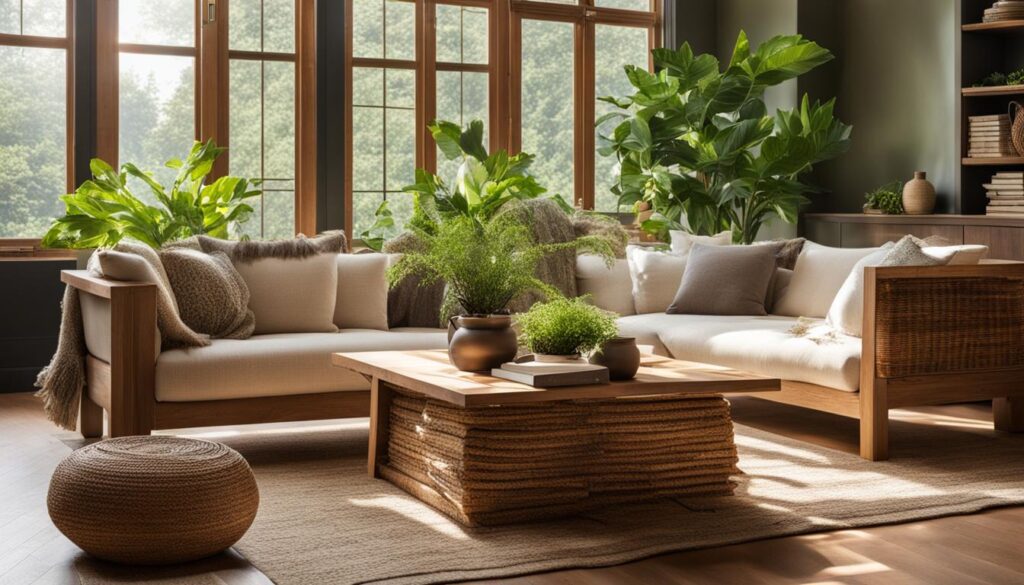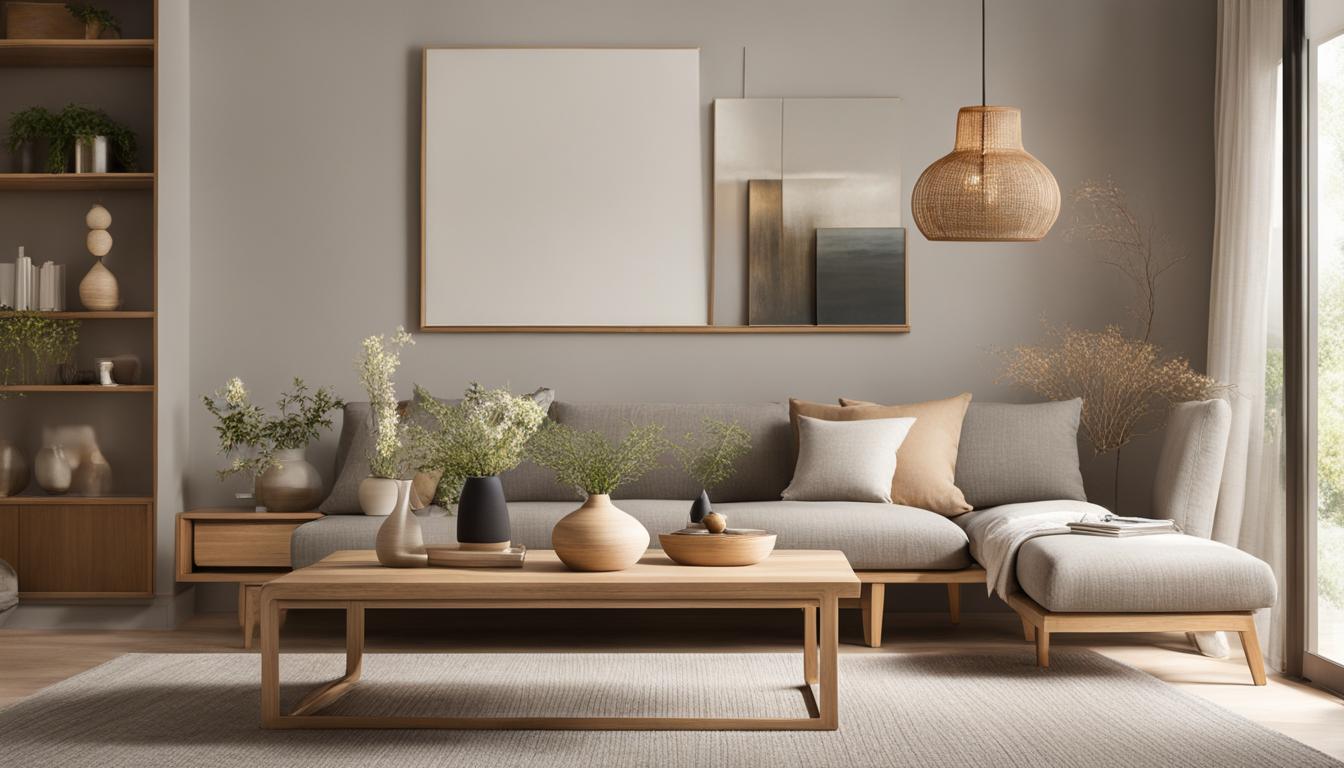Welcome to your guide to creating a stunning and functional Japandi living room. Japandi living rooms are a popular design trend that combines the principles of modern Japanese and Scandinavian design. This fusion style celebrates simplicity, natural materials, and minimalist aesthetics.
In this guide, we will explore how to incorporate the elements of Japandi interior design into your home. From choosing the right materials and colors to selecting the perfect furniture, we will help you create a tranquil haven of minimalist elegance.
Key Takeaways:
- Japandi living rooms combine Japanese and Scandinavian design principles.
- Natural materials like wood, bamboo, and stone are essential in Japandi interiors.
- Minimalist design and functionality are key components of Japandi living rooms.
- Neutral color palettes with accents of muted blues, greens, and browns create a serene atmosphere.
- Create a harmonious space by blending simplicity, functionality, and elegance in your Japandi living room.
Embracing Natural Materials in Your Japandi Living Room

When creating a Japandi living room, one of the key elements to consider is the use of natural materials. These materials not only bring a sense of warmth and connection to nature but also align with the sustainable principles of both Japanese and Scandinavian design. By incorporating natural materials, you can enhance the overall aesthetic and create a harmonious space that reflects the essence of Japandi interior design.
Wood is a central element in Japandi living rooms. Light woods like oak are commonly used to achieve a minimalist and natural look. However, don’t be afraid to experiment with darker woods for a striking contrast. Bamboo is another popular material in Japandi design, known for its durability and eco-friendly properties. Incorporating bamboo furniture or accents can add a touch of elegance to your space.
In addition to wood and bamboo, other natural materials such as hemp, stone, marble, and linen can also be embraced in your Japandi living room. These materials bring texture and visual interest to the space, creating a sense of depth and tranquility. Whether it’s a stone coffee table, a linen sofa, or a hemp rug, each piece contributes to the overall aesthetic and promotes a calm and inviting atmosphere.
Choosing the Right Natural Materials
- Opt for light woods like oak or bamboo for a minimalist and natural look.
- Consider incorporating darker woods for a striking contrast.
- Embrace natural materials like hemp, stone, marble, and linen for texture and visual interest.
- Choose sustainable and eco-friendly options to align with the principles of Japandi design.
By embracing natural materials in your Japandi living room, you can create a space that exudes tranquility and elegance. The use of wood, bamboo, hemp, stone, marble, and linen brings a sense of harmony and connection to the natural world. Remember to choose sustainable and eco-friendly options whenever possible to align with the principles of Japandi interior design. With the right materials, your Japandi living room will become a sanctuary of minimalist beauty and timeless style.
The Importance of Minimalist Design in Japandi Living Rooms
When it comes to Japandi interior design, minimalist design plays a crucial role in creating a harmonious and serene living space. The clean lines and clutter-free aesthetic of minimalist design help to achieve the perfect balance between Japanese and Scandinavian influences. By embracing minimalist principles, you can create a high-quality, functional space that exudes elegance and tranquility.
Simplicity and Clean Lines
In a Japandi living room, simplicity is key. Opt for furniture and decor with clean lines and a sleek, understated design. Minimalist pieces with straight edges and simple shapes will complement the overall aesthetic of your space. Avoid ornate details and intricate patterns, as they can detract from the minimalist charm of Japandi design.
A Clutter-Free Haven
One of the defining features of minimalist design is the absence of clutter. A Japandi living room should be kept clean and free from unnecessary items. Consider incorporating storage solutions like built-in shelving or hidden storage units to keep your space organized and clutter-free. By decluttering your living room, you can create a serene and peaceful environment that promotes relaxation and mindfulness.
A Focus on Functionality and Quality
In Japandi design, functionality is equally important as aesthetics. Choose furniture and decor pieces that serve a purpose and contribute to the overall functionality of your living space. Opt for high-quality materials and craftsmanship that will stand the test of time. By prioritizing functionality and quality, you can create a living room that not only looks beautiful but also serves your everyday needs.
Choosing the Perfect Color Palette for Your Japandi Living Room

When it comes to creating a Japandi living room, choosing the perfect color palette is essential to achieving the desired aesthetic. The goal is to create a harmonious blend of Japanese and Scandinavian design, combining neutral tones with subtle pops of color. The key is to maintain a calm and tranquil atmosphere while still infusing your space with warmth and visual interest.
Neutral Palette:
A neutral color palette forms the foundation of a Japandi living room. Shades of white, cream, beige, and grey provide a clean and serene backdrop. These colors create a sense of simplicity and allow the natural materials in the room to take center stage. To add depth and contrast, you can incorporate black and gold accents through furniture pieces or accessories.
Soft Pastels:
To introduce subtle pops of color into your Japandi living room, consider incorporating soft pastels. Muted blues, greens, and browns can add a touch of tranquility and bring a sense of nature indoors. These hues can be incorporated through cushions, rugs, or artwork, allowing you to easily change and update the color scheme as desired.
Creating Balance:
When incorporating color into your Japandi living room, it’s important to maintain a sense of balance. Keep larger furniture pieces and walls in neutral tones to create a calming atmosphere, while using bolder colors sparingly for accent pieces. This will ensure that the overall look remains cohesive and in line with the minimalist elegance of Japandi design.
By carefully selecting a color palette that embraces neutral tones and soft pastels, you can create a Japandi living room that exudes tranquility and minimalist elegance. Remember to prioritize simplicity and balance in your design choices, allowing the natural materials to shine and creating a harmonious space that celebrates the fusion of Japanese and Scandinavian aesthetics.
Conclusion
Embrace the fusion design trend of Japandi interior design and create a tranquil haven of minimalist elegance in your living room. By combining the simplicity and functionality of Japanese and Scandinavian design, you can achieve a space that is both stylish and serene.
Utilize natural materials such as wood, bamboo, and linen to establish an organic and sustainable atmosphere. Opt for clean lines and clutter-free spaces to maintain the minimalist aesthetic, while maximizing functionality with storage units.
When selecting a color palette, stick to neutral tones like white, cream, and beige, with subtle pops of color through muted blues, greens, and pastel reds. Remember to keep larger furniture pieces neutral, and use bolder hues for decorative accessories such as vases, cushions, and rugs.
With Japandi interior design, simplicity meets functionality, creating a harmonious and inviting living space. So, go ahead and transform your living room into a peaceful retreat where minimalist elegance reigns supreme.

